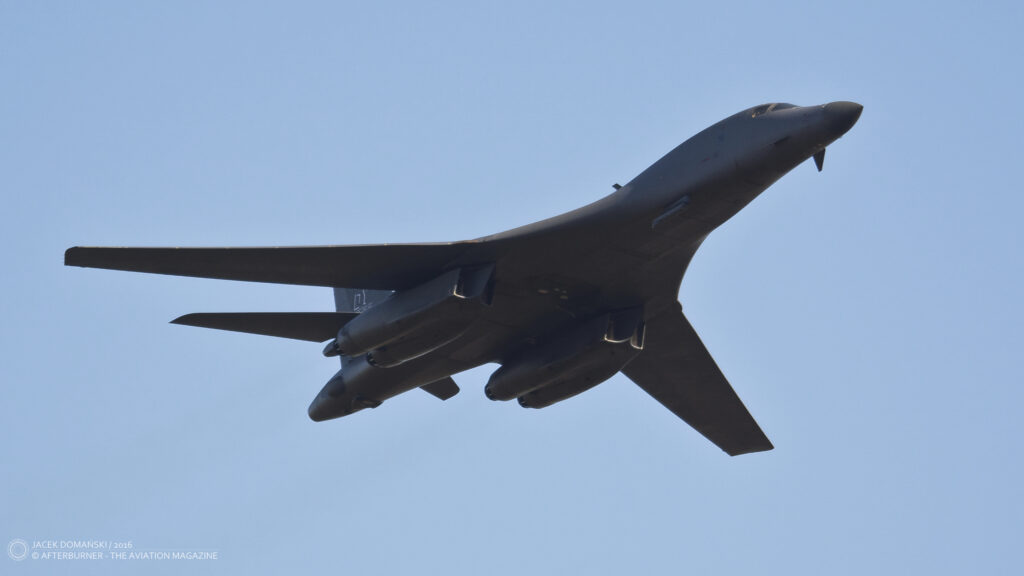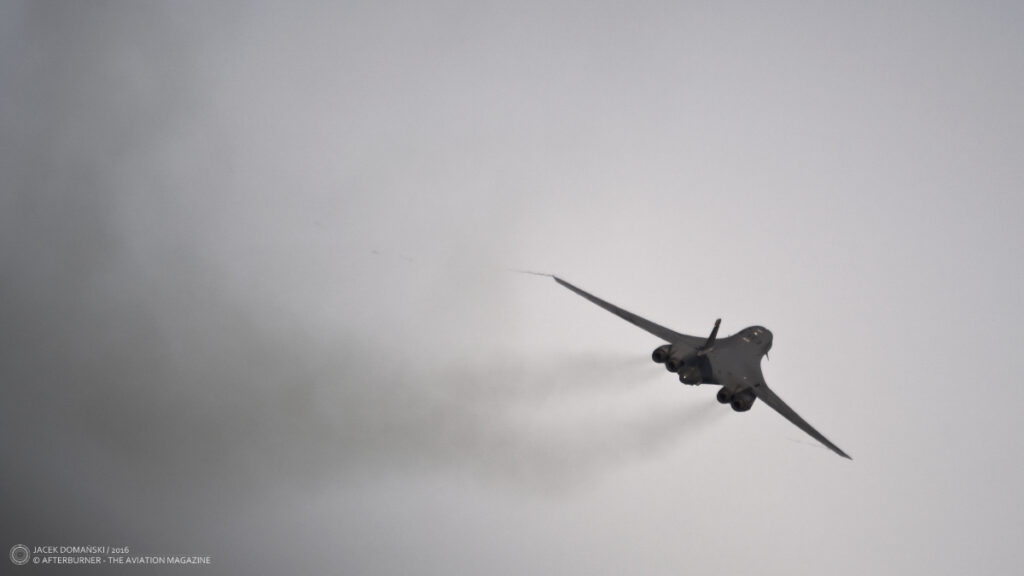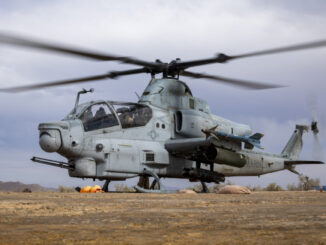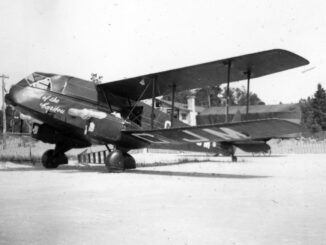 On 23rd December 1974, prototype of Rockwell B-1 Lancer supersonic strategic bomber performed its maiden flight.
On 23rd December 1974, prototype of Rockwell B-1 Lancer supersonic strategic bomber performed its maiden flight.
For the first time, the idea of a large, supersonic strategic bomber emerged in the middle of 1950s and originated from a simple ´what if…´ question. What if we merge B-58 Hustler supersonic ability and Mach 2 speed with range and payload of B-52 Stratofortress?
Possible outcome of the abovementioned merge seemed so promising that it was worth to change that hypothetical idea into a feasibility study. In December of 1957 it already turned into an official USAF programme, creating a huge, six-engine supersonic bomber – North American Aviation XB-70 Valkyrie.
At that time, the XB-70 concept was considered the ideal strategic bomber for the USAF. The aircraft was able to cruise at Mach 3 speed, fly at altitude of 70,000 feet (approximately 21,000 metres) and thus staying out of reach of the Soviet fighter interceptors and anti-aircraft defence.
However, the 1960 U-2 incident proved the aforementioned conception wrong. It became clear to the American authorities that even the high-flying aircraft were no longer immune to Soviet surface-to-air missiles. Therefore, the doctrine was changed from high- to low-level penetration. It also meant cancellation of the XB-70 programme, as the design of the Valkyrie was optimized only for high-altitude performance.
Initially, there were some attempts to turn the B-52 into that new role of low-level penetrator. However, as they have not brought successful results, a so-called penetrator aircraft was created to perform combat tasks within the new doctrine – able to fly long-range, low-altitude missions with supersonic speed. Those aeroplanes, such as F-111 or Panavia Tornado, were usually fighter-bombers designed with variable-sweep wing technology and capable of carrying nuclear loads. Although satisfactory fulfilling their basic tasks, the penetrators still were far away from playing the role of supersonic strategic heavy bomber.

Nevertheless, the series of feasibility studies continued. In 1961, Subsonic Low-Altitude Bomber (SLAB) concept was introduced in the US, featuring an aircraft with large swept wing, T-tail and turbofan engines. That design was more of a shape of nowadays airliners than strategic bomber and was quickly abandoned. Then, Extended Range Strike Aircraft (ERSA), Low-Altitude Manned Penetrator (LAMP) and Advanced Manned Strategic Aircraft (AMSA) followed, bringing some interesting, and fresh, ideas to the subject of the low-penetration bomber – as well as pompous names and fancy acronyms for their programmes – however not moving the concept any further.
At that time, given the number of studies and time spent on creating the low-penetration bomber, the acronym of the AMSA programme was often ironically explained as ´America´s Most Studied Aircraft´.
Fundamental change occurred with Richard Nixon´s presidency. He not only put emphasis on the AMSA programme, but also secured its financing and assigned right people to take care of the development. In April of 1969, the programme was officially renamed B-1A – it was the initial entry of the new bomber designation series, although it was originally introduced back in 1962.
The works on the new strategic bomber gained serious momentum and in November of 1969, the USAF issued official requirements and request for proposals. It was responded by Boeing, General Dynamics and North American Rockwell. Yet in June of 1970, the latter company was awarded the development contract for two test airframes and five prototypes (however, it was later cut to just one test airframe and three prototypes).
It was then expected the new aircraft would enter operational service in 1979 and initial plans expected 240 B-1 bombers to be built in total.
While working on the final shape of the new supersonic bomber, Rockwell International – as new name of the company was since the beginning of the 1970s – drew heavily from ideas and developments created during several years of studies. Several features were also taken from the F-111 and XB-70 Valkyrie.
The aircraft created by Rockwell engineers was powered with four turbofan engines, featured variable-sweep wing and a crew escape capsule. Initial requirement for achieving Mach 1.2 speed at low altitude was reduced to Mach 0.85, due to cost of necessary titanium elements. The first prototype was ready in October of 1971, however almost three hundred alterations and improvements were made to make it airworthy and to meet the operational requirements.

Finally, on 23rd December 1974, the B-1A supersonic bomber performed its maiden flight. However, this did not mean the end of development issues.
At the time of the first flight, the cost of one B-1A aircraft was approximately 70 million USD. It was almost twice as initially estimated and, therefore, it was heavily criticised by the Democratic Party.
In 1977, the US President´s office was taken by Jimmy Carter, member of the Democratic Party. As expected, he ordered the B-1A programme to be revised. Taken into consideration the ongoing stealth bomber development, as well as capabilities of the new range of the intercontinental ballistic missiles, on 30th June 1977 Carter announced cancellation of the B-1A programme.
Nevertheless, testing of the prototypes was continued until 1981. There was a strong belief among the Department of Defense officials, the USAF and the Rockwell engineers, that the B-1 programme can hope for better times.
And indeed – in 1981, Ronald Reagan became the new US President. Following the current international developments and increasing political tensions, as well as delays in the stealth bomber programme, Reagan decided to continue with the B-1 programme.
On 2nd October 1981, Reagan announced that 100 B-1 bombers were ordered for the USAF. However, the aircraft had to be significantly redeveloped and the new version was then designated B-1B.
But – as Kipling used to say – that´s another story and it will be continued in one of our next articles focused on Aviation History.




